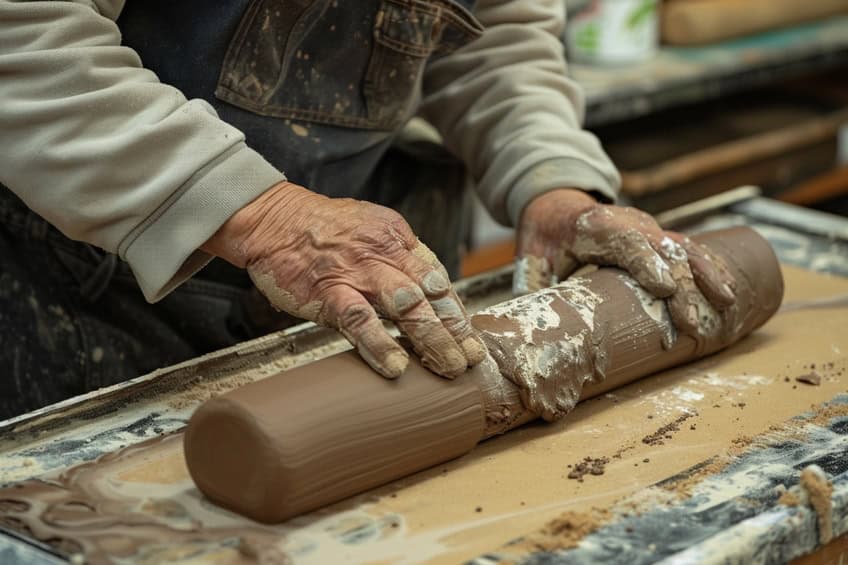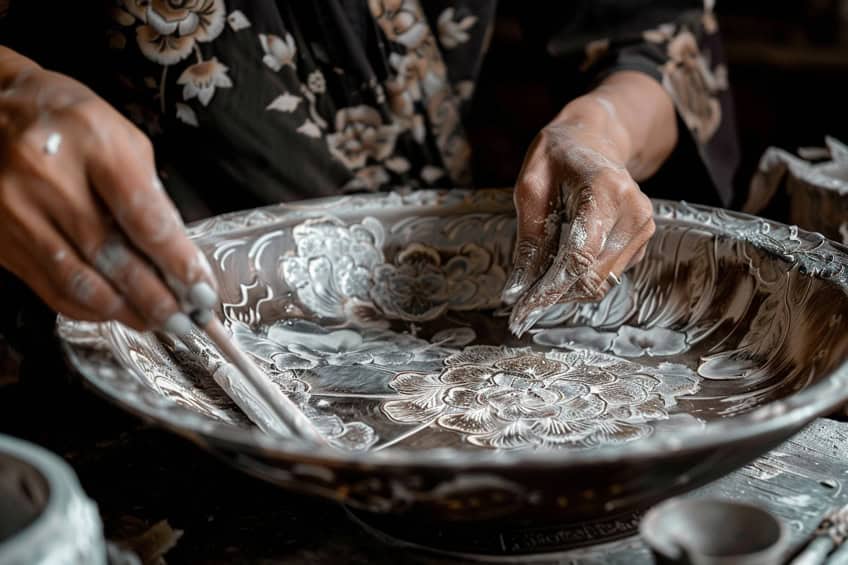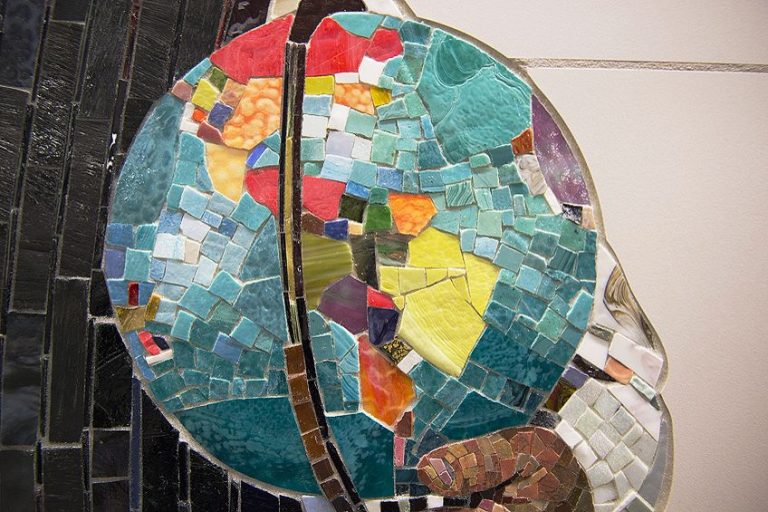Ceramic Techniques – From Clay to Creation
Welcome to the colorful world of ceramic mastery! In this exciting journey through clay and fire, we’ll dive into the artistry and techniques that transform humble mud into stunning pottery. From hand-building to wheel-throwing, glazing to firing, get ready to explore the magical realm where creativity meets craftsmanship. Whether you’re a seasoned potter or a curious beginner, prepare to be enchanted by the secrets of ceramic techniques!
Key Takeaways
- Ceramics have a rich history, from early artifacts to modern creations.
- Core techniques include hand-building, throwing, glazing, and firing.
- The transformation from clay to finished ceramics involves skillful artistry and science.
Historical Development of Ceramics
Ceramics have played an integral role in human culture for millennia, serving both utilitarian and artistic purposes. The earliest artifacts date back to the Upper Paleolithic period, indicating the long-standing relationship between humans and ceramic materials. The creation process begins with raw clay, a pliable, earthy material that can be shaped by hand or on a potter’s wheel. Once formed, the clay bodies are often adorned with glazes, a glass-like coating that not only serves to decorate but also waterproofs the ceramic pieces.

The core ceramic techniques have evolved over time and continue to be expanded upon by contemporary artists and craftsmen. These techniques include hand-building methods like pinching, coiling, and slab construction, as well as throwing on a wheel. Following shaping and decorating, the ceramics must undergo firing—a high-temperature baking process that hardens the clay. The kiln’s heat triggers chemical changes that solidify the ware, making it both durable and functional.
For pieces like Raku pottery, unique post-firing methods can also be applied to achieve specific finishes and textures.
Neolithic Period
During the Neolithic period, human societies transitioned from nomadic to settled lifestyles, which was reflected in the development of ceramics. They created terracotta, one of the earliest forms of ceramic. Neolithic potters hand-shaped clay into forms that were then dried and fired in open bonfires to harden.
Ancient Greece
Ancient Greece brought refinement to ceramic arts. Here, terra sigillata, a fine, red-gloss pottery, was crafted. Greek artisans used precision wheel-throwing techniques, enabling the creation of symmetrical and sophisticated shapes. They introduced decorative elements like the black-figure and red-figure painting techniques.

Silk Road Influence
The Silk Road facilitated cultural exchanges that were crucial for ceramic innovations. Chinese potters discovered kaolin clay, leading to the birth of porcelain around the 200 CE mark. High-fired ceramics were traded, influencing pottery techniques across Asia and Europe.
The Silk Road’s impact on ceramics spread various glazing techniques and forms, such as blue and white porcelain.
Fundamental Ceramic Techniques
Ceramic making is an art form rooted in ancient practices, perfecting the balance between creativity and technical skill. Each technique requires a degree of precision and develops specific capabilities in the artist.

Handbuilding
Handbuilding is the most primitive yet versatile ceramic technique. It allows for the creation of forms that are often impossible to achieve on a pottery wheel as it allows artists to sculpt clay by hand. There three main hand-building methods include pinch pottery, coil construction, and slab building.
Pinching
Pinching, a subset of handbuilding, is used for making smaller, more delicate items. The artist must have a gentle touch to form the clay without compromising the structure, illustrating how sensitivity in shaping impacts the final product.

Coil Construction
Coil construction is another handbuilding method where rolled clay coils are carefully stacked and smoothed to create pottery. The technique is valued for its rhythmic process and the textural possibilities offered by the visible coils, which can be left apparent or smoothed out.
Slab Construction
Working with slabs involves rolling out clay to an even thickness and cutting shapes to assemble. These slabs can be draped over or into forms to create complex structures with crisp edges and smooth surfaces.

Wheel Throwing
Wheel throwing requires a pottery wheel, where a lump of clay is centered and then skillfully shaped by hands or tools while it spins. The key skills necessary for wheel throwing are control and symmetry to create uniform pieces.
Slip Casting
Slip casting is used for producing multiple identical shapes by pouring liquid clay, known as slip, into a plaster mold. Once the slip solidifies, the mold is removed, revealing a repeatable form that can then be further refined.

Decorating and Glazing Ceramics
In the field of ceramics, the twin arts of decorating and glazing are essential for creating both functional and visually appealing pieces. These processes involve a variety of techniques that involve the application of color and finishes, each with its unique characteristics and outcomes.
Ceramic Decorating Techniques
One of the primary aspects of ceramic decoration is the use of color to enhance the visual appeal of the pottery. Color can be added to ceramics using different pigments and slips, often applied with brushes or through slip trailing—a process where liquid clay slip is squeezed onto the surface through a nozzle, creating intricate patterns. Another popular method is sgraffito, where artists scratch away the surface of a slip-coated piece to reveal the clay body beneath.

This technique allows for a contrast between the slip color and the body’s natural color, enabling detailed two-tone decoration. Sgraffito tools can range from needles and carving tools to homemade implements. Carving and Mishima: Deep carving into the clay provides texture and three-dimensional patterns. The Mishima technique is also applied to carve into the surface, then inlay with colored slip, and wiped clean to show the design flush with the ceramic surface.
Glazing Techniques
A fundamental glazing technique is pouring, where glaze is poured into and over the piece to ensure an even layer coats the interior. Excess glaze is then poured back out. Pouring typically covers the interior surfaces quickly. Glazes may also be applied with brushes for a more controlled finish or sprayed for uniform coverage or special effects such as gradients and speckles. Identifying the correct firing temperature is crucial for a successful glaze. Low-fire glazes, which melt at approximately 1845 degrees Fahrenheit, are best for achieving precise, controlled designs.
Conversely, mid-fire glazes require higher temperatures between 2100 – 2300 degrees Fahrenheit.
Regardless of the chosen glazing technique, cleaning the piece’s bottom is imperative to avoid glaze sticking to kiln shelves during the firing process. Each decorating and glazing technique imparts unique qualities to the final ceramic piece, influencing not only the aesthetics but also its texture and functionality. By mastering these methods, potters can create an endless variety of ceramic art.
Firing Processes and Finalization
The final stage of creating ceramic pottery is the firing process, which solidifies and transforms the clay. The type of kiln used and the temperatures achieved during firing critically influence the finished product’s durability, appearance, and structural integrity.

Kiln Types and Firing Temperatures
Ceramic artists use a variety of kilns, each offering different features suitable for specific firing processes:
- Electric kilns: Popular in modern studios, electric kilns provide controlled, consistent heating and are preferred for their ease of use. They typically fire at temperatures up to 2,200 degrees Fahrenheit (1,204 degrees Celsius) for high-fire ceramics.
- Gas kilns: These kilns use propane or natural gas and allow for varying atmospheric conditions inside the kiln, which can affect the final color and finish of the pottery.
- Wood kilns: Creating a natural ash glaze, wood kilns require constant attention to maintain the fire and temperature, and can reach similar high-fire temperatures to electric and gas kilns.
Firing temperatures are categorized into low, mid, and high ranges, each suitable for different clay bodies and desired outcomes:
- Low-fire: Up to 2,012 degrees Fahrenheit (1,100 degrees Celsius)
- Mid-range fire: 2,100 – 2,237 degrees Fahrenheit (1,150 – 1,225 degrees Celsius)
- High-fire: Above 2,237 degrees Fahrenheit (1,225 degrees Celsius)
Raku and Alternative Firing
Raku firing is a distinct process with its own set of techniques and outcomes. A low-fire process that typically reaches about 1,832 degrees Fahrenheit (1,000 degrees Celsius). Once the pottery reaches the required temperature, it is removed from the kiln and placed into containers with combustible materials, inducing a reduction atmosphere.

Alternative firings include methods such as pit firing and sawdust firing, which don’t rely on conventional kilns but still produce unique finishes and colors on the ceramics. These techniques often involve firing pottery in open pits or containers filled with organic material that influence the final appearance through smoke and ash effects.
Ceramic techniques are not just about shaping clay; they’re about unleashing your imagination and creating something truly unique. Whether you prefer the precision of wheel-throwing or the tactile joy of hand-building, there’s a world of possibilities waiting for you in the realm of ceramics. So grab your tools, dive into the clay, and let your creativity soar as you explore the endless wonders of this ancient art form. Happy potting!
Frequently Asked Questions
What Are the Essential Techniques for Beginners to Learn in Ceramics?
For those starting in ceramics, a few key techniques form the building blocks of the craft. These include hand-building methods such as pinching, which involves shaping clay with your fingers; coiling, where clay is rolled into long strands and then layered to build up forms; and slab construction, which uses flattened pieces of clay to assemble objects. Mastery in these techniques provides a solid foundation for creating a variety of ceramic objects.
What Are the Basic Methods Involved in Creating Ceramic Pieces?
The basic methods for creating ceramic pieces involve hand-building, wheel throwing, and slip casting. Hand-building uses simple tools and hands to form clay, which is suited for sculptural pieces and allows for a direct and tactile approach. Wheel throwing is centered on shaping clay on a potter’s wheel, which is ideal for symmetrical forms like bowls and vases. Slip casting involves pouring liquid clay into molds to achieve uniform shapes which are then fired in a kiln to solidify.
What Are Some Unique Pottery Techniques That Are Less Common?
Unique pottery techniques that are less commonly practiced involve raku firing, a technique involving rapid heating and cooling that creates distinctive crackled glazes. Another is sgraffito, where an artist applies layers of contrasting colored slips or underglazes to leather-hard clay and then carves away parts to reveal the underlying layer. Additionally, there are various decorative techniques such as incising or impressing patterns onto the clay surface before the firing process.
Isabella studied at the University of Cape Town in South Africa and graduated with a Bachelor of Arts majoring in English Literature & Language and Psychology. Throughout her undergraduate years, she took Art History as an additional subject and absolutely loved it. Building on from her art history knowledge that began in high school, art has always been a particular area of fascination for her. From learning about artworks previously unknown to her, or sharpening her existing understanding of specific works, the ability to continue learning within this interesting sphere excites her greatly.
Her focal points of interest in art history encompass profiling specific artists and art movements, as it is these areas where she is able to really dig deep into the rich narrative of the art world. Additionally, she particularly enjoys exploring the different artistic styles of the 20th century, as well as the important impact that female artists have had on the development of art history.
Learn more about Isabella Meyer and the Art in Context Team.
Cite this Article
Isabella, Meyer, “Ceramic Techniques – From Clay to Creation.” Art in Context. April 19, 2024. URL: https://artincontext.org/ceramic-techniques/
Meyer, I. (2024, 19 April). Ceramic Techniques – From Clay to Creation. Art in Context. https://artincontext.org/ceramic-techniques/
Meyer, Isabella. “Ceramic Techniques – From Clay to Creation.” Art in Context, April 19, 2024. https://artincontext.org/ceramic-techniques/.









